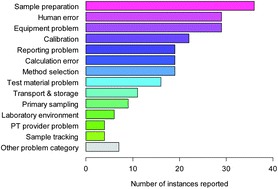What causes most errors in chemical analysis?
Abstract
In the early 1980s, emerging evidence of poor inter-laboratory precision in routine analysis for trace contaminants led to major changes in the management of analytical chemistry. The adoption of the CODEX and later VAM principles encouraged laboratories to participate regularly in proficiency test (PT) schemes; to adopt validated analytical methods; to rely increasingly on certified reference materials for calibration and validation of their test methods; to implement effective internal QC; and (more recently) to obtain accreditation to standards such as ISO 17025.

- This article is part of the themed collection: Analytical Methods Committee Technical Briefs

 Please wait while we load your content...
Please wait while we load your content...